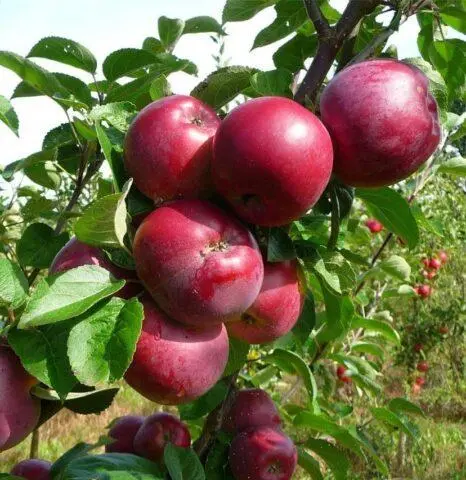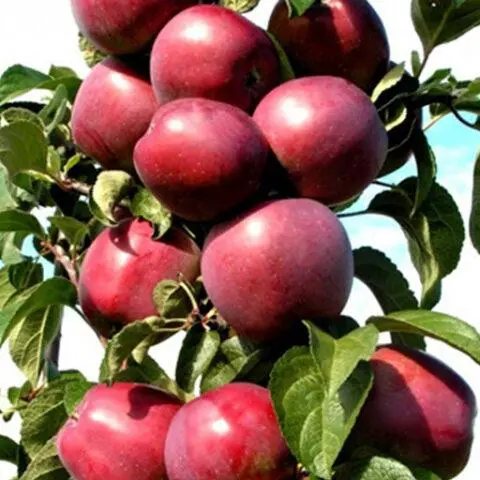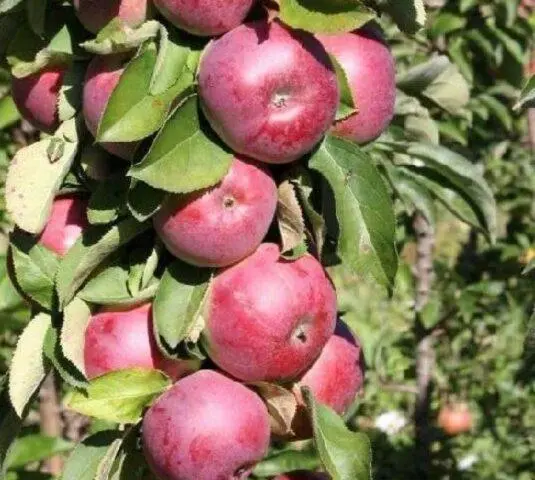Contents
- History of breeding
- Description and characteristics of the columnar apple tree Chervonets
- Advantages and disadvantages
- Planting a columnar apple tree Chervonets
- Caring for the columnar apple tree Chervonets
- Fighting diseases and pests
- Collection and storage
- Conclusion
- Reviews of gardeners about the columnar apple tree Chervonets
Chervonets apple tree is a well-known domestic variety, characterized by large and sweet apples with a pleasant aroma. The yield is consistently high, up to 8 kg from an adult tree. Culture is grown both for themselves and for commercial purposes. Winter hardiness is relatively high. This allows growing seedlings in most regions of Central Our Country.
History of breeding
Chervonets apple tree was bred by Morozova N.G. and Kichina V.V. in 1983. The variety was obtained on the basis of a complex crossing of several varieties:
- SR0523;
- Melba’s Order;
- Leader;
- hybrid Wolf River x M. atro sangujnea.
Subsequently, successful tests were carried out, and in 1990, breeders selected several seedlings. They were grown separately, and already in 1996 the Chervonets variety was bred. An application for registration was filed in 2005, and in 2008 it was included in the register of breeding achievements in Our Country.
The applicant and originator is the Federal State Budgetary Institution “FNTs Horticulture”, the licensee is Center Ogorodnik LLC. The culture is approved for cultivation in all areas of the Central region, including in the middle lane, the Volga region and the Black Earth region.
Description and characteristics of the columnar apple tree Chervonets
Apple variety Chervonets gives a tree with a columnar crown. The height is small, which makes it easier to care for and pick apples. The yield is high, and the taste of the fruit is quite pleasant. This allows the apple tree to be grown commercially.
tree appearance
The tree of the Chervonets variety is medium-sized, semi-dwarf type. The crown is compact, not sprawling, the height reaches 2 m. The shoots are short, diverge at sharp angles, firmly connected with skeletal branches. They are pressed against each other, do not diverge in breadth, which ensures the formation of a not too dense crown of a columnar type.
The foliage of the Chervonets apple tree is quite good. The foliage is large, broadly ovate, deep green in color. The top is twisted. The base of the plate is round, a slight sheen is noticeable on the surface. Petioles moderately long and not too thick.
Description of fruits

The fruits of the Chervonets apple tree are quite large
By weight, apples reach an average of 180 g, although specimens of 200-250 g are often found. The maximum recorded record was 350 g. The appearance is attractive. The shape is round, the fruits are one-dimensional, the skin is quite dense, with a gloss. Raspberry-red color, with a blush. The name “Chervonets” is associated precisely with the appearance of apples – in the sun they shine like coins.
Subject to storage conditions, they lie in the cellar for up to 45-60 days, after which they must be eaten or processed.
Taste of Chervonets apples
The taste of Chervonets apples is pleasant, with a pronounced sweetness, dessert type. At the tasting, it received a rating of 4,3 points out of 5 possible. There is a pleasant, balanced acidity. The aroma is weak. The pulp is dense, with a cream shade, the structure is fine-grained, the juiciness is high.
When and how it blooms
Chervonets apple tree blooms in the second half of May, sometimes with a delay – the first decade of June (if the spring turned out to be cold and rainy). The flowers are fragrant and beautiful, pure white, often with a light pink color in the sepals. Arranged in inflorescences of 7-9 pieces.
Pollinators of the columnar apple tree Chervonets
The variety is characterized by high yield, however, to maintain stable fruiting, it is recommended to plant several pollinators. These can be apple trees with late fruiting, for example:
- Spartan;
- Antey;
- Antonovka;
- Bogatyr;
- Jonathan;
- Ligol;
- Memory of Isaev and others.

For cross-pollination, the Spartan variety and other varieties with late flowering periods are suitable.
Fruiting terms
In terms of fruiting, the Chervonets apple variety belongs to autumn. The fruits ripen by the third decade of September. At this point, they reach the stage of full (biological) ripeness. The first fruits are formed already in the second year after planting seedlings. Full fruiting occurs already at 5-6 years, and the jump occurs like an avalanche.
Productivity
The yield of Chervonets apple tree is quite high and reaches 6-8 kg. The culture reaches this indicator by the age of 5-6. With proper care, yields can be maintained at a stable level for many years.
Frost resistance
In terms of winter hardiness, the Chervonets apple tree can be compared with the Melba variety. Even in severe winters, the degree of freezing is estimated at a maximum of 1-2 points. Therefore, culture can be grown in different regions of Central Our Country – from the south to the middle zone and even to more northern territories.
Disease resistance
Chervonets apple tree has a fairly good immunity to scab. In rare cases, she may be affected by this fungus, but to a small extent (maximum 2 points). However, damage by rust, powdery mildew, as well as aphids, bark beetles, suckers and other pests is not excluded. Therefore, it is important to periodically inspect the plantings and regularly treat with fungicides and insecticides.
Advantages and disadvantages
The Chervonets apple variety has tangible advantages. The fruits are tasty and juicy, quite large. The culture itself is unpretentious, so even a novice gardener can handle the care.

The fruits of the Chervonets apple tree are distinguished by an attractive presentation
Pros:
- pleasant taste;
- stable yield;
- keeping quality;
- transportability;
- the tree is neither tall nor spreading.
Cons:
- no immunity to many common diseases;
- may suffer from winter frosts;
- to maintain a stable yield, pollinators need to be planted.
Planting a columnar apple tree Chervonets
Chervonets apple tree seedlings are planted from the first half of April to the first decade of May. If the deadline is missed, autumn planting is also allowed, which is scheduled for the end of September – the beginning of October (three weeks before the first frost). Specific dates depend on the climate of a particular region.
For planting Chervonets apple trees, well-lit areas without stagnant water are chosen. The soil should be loose and fertile, pH in the range of 6,0-7,0. On the eve of planting, the soil is dug up and fertilized with organic matter – 5 kg of compost or humus per square meter.
The sequence of actions when planting an apple tree of the Chervonets variety is as follows:
- Dig several holes at a distance of at least 3 m. Their depth should be 60 cm, diameter 70 cm.
- Lay small stones at the bottom.
- Place the seedling in the center.
- Sprinkle with fertile soil.
- Tamp it so that the root neck remains 5-7 cm above the surface.
- Pour a bucket of water (it needs to be defended) and mulch.
Caring for the columnar apple tree Chervonets
To get a good harvest of apples, as in the description of the Chervonets variety and in the photo, it is recommended to follow the following care rules:
- The variety is moisture-loving, so watering is done at least three times during the season – 8-10 buckets for each adult tree.
- In the spring, compost or humus is added to the trunk circle – a bucket per tree. You can give a solution of urea (15 g per 10 liters).
- In autumn, the apple tree Chervonets is given a complex fertilizer, for example, Autumn Kemira or superphosphate (40 g per 10 l) and potassium sulfate (25 g per 10 l).
- The soil in the trunk circle is periodically loosened, weeding is done.
- If after the June litter there are too many ovaries left on the tree, the excess is removed manually.
- Chervonets apple tree pruning is carried out regularly for sanitary and formative purposes – in spring and autumn.
- For the winter, the trunk circle is mulched with hay, sawdust, straw or other materials.

Even minimal crop care will ensure a stable harvest.
Fighting diseases and pests
The register of breeding achievements does not provide data on the resistance of the Chervonets apple tree to certain diseases. Therefore, processing must be carried out according to the general scheme:
- in early spring;
- before and after flowering;
- in the middle of autumn.
Fungicides are used to prevent fungal infections:
- “Score”;
- “Horus”;
- “RAW”;
- “Bordeaux liquid”;
- “Strobe” and others.
To combat aphids, bark beetles, spider mites and other pests, insecticidal preparations are used, for example:
- “Decis”;
- “Vertimek”;
- “Fitoverm”;
- “Fufanon”;
- “Aktara” and others.
Chervonets apple trees are processed in calm and dry weather, and it is advisable to do this in the late evening in order to prevent leaf burns due to the bright sun.
Collection and storage
Harvested during the second and third decade of September. Apples are plucked along with the stalk, consumed fresh, used for processing or sent for storage. The fruits are placed in two layers in wooden boxes. Stored in the cellar under standard conditions:
- temperature in the range of 2-10 degrees above zero;
- humidity 60-70%;
- complete darkness;
- good air circulation (periodically need to be ventilated).

Apples ripen in the second half of September
Conclusion
Chervonets apple tree is quite unpretentious in care. The culture gives a good harvest. The fruits are large, attractive, transportable, suitable for sale and processing. The tree is productive, from the fifth year it gives at least 6 kg of yield.









